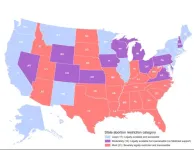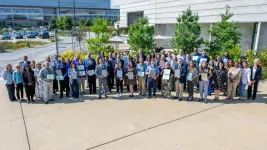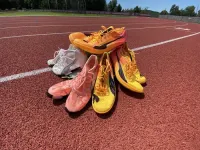(Press-News.org) DALLAS (SMU) – When SMU researcher Alexander Chase was a young boy, the sheer diversity of plants in Earth’s tropical rainforests fascinated him. He found himself wondering, what new species were out there, waiting to be unearthed? That curiosity is why Chase now collects samples from Earth’s oceans using a new technique called Small Molecule In situ Resin Capture (SMIRC), which could be the first step in uncovering compounds that lead to next-generation antibiotics.
Microbial natural products come from microorganisms, or microbes, and account for many of today’s essential medicines, including most antibiotics. Microbes are too small to see without a microscope and produce a wide variety of chemical compounds as part of their lifespan, some of which are useful for pharmaceutical applications. Traditionally, these compounds are discovered using a ‘microbe-first’ approach, where individual strains are cultured in the laboratory from a sample picked up in the wild.
While this method has been effective, it has become increasingly difficult for researchers to use it to uncover new chemical “scaffolds”, which serve as the foundation upon which chemical compounds are built. Chemical scaffolds are a critical resource for drug discovery.
“Right now, when we collect new samples and culture the microbes, we’re discovering scaffolds that essentially are very similar to the ones we already know about,” explains Chase, an assistant professor in the Roy M. Huffington Department of Earth Sciences. “It’s been really difficult over the last few decades to find something that is new with the ‘microbe-first’ approach, which essentially limits us to the same or similar bacterial strains and their chemical compounds that represent only a fraction of the natural diversity out in the ocean. That’s where SMIRC comes in, it allows us to explore the unknown.”
A recent study in the journal Nature Communications by Chase and researchers at the University of California San Diego and University of California San Francisco explains how SMIRC made possible the collection of microbial natural products where they are produced in the wild, without the need to be cultured in a lab. It used an absorbent resin called HP-20, which acts like a sponge to capture the chemicals released by microbes.
As a test, the researchers used SMIRC in areas covered in seagrass near San Diego. From the chemicals collected, they found an antibiotic compound and also a chemical called chrysoeriol, which is plant-based that has antibacterial properties. A modified version of SMIRC was then used by mixing the HP-20 with agar, a substance that encourages the growth of microbes. This second experiment uncovered aplysiopsene A, which showed continued success of the SMIRC technique for recovering compounds.
A third test used SMIRC in a protected marine reserve at Cabrillo National Monument. Here the technique collected larger samples that contained more complex chemical mixtures. While the reason for the site to be rich in novel compounds is currently unknown, the researchers speculate it could be because this specific area is exposed to little human traffic.
Although none of the new compounds proved to be a path to new antibiotics, one of the compounds discovered, dubbed cabrillostatin, does show bioactivity and is being pursued as a possible new approach to cancer and heart care.
“The ocean is one of the least explored areas on Earth, especially the deep ocean,” said Chase. “There’s so much we don’t understand about marine microorganisms and the compounds they produce. Because of antibiotic resistance and other health challenges, there is a high priority for natural product research. With SMIRC, we now have an easily deployable system that makes it possible for researchers to study compounds previously out of reach.”
About SMU
SMU is the nationally ranked global research university in the dynamic city of Dallas. SMU’s alumni, faculty and more than 12,000 students in eight degree-granting schools demonstrate an entrepreneurial spirit as they lead change in their professions, communities and the world.
END
SMU researcher helps develop new technique to explore oceanic microbes
Known as SMIRC, the technique could uncover new antibiotics
2024-09-04
ELSE PRESS RELEASES FROM THIS DATE:
New guideline for Helicobacter pylori includes change to primary treatment recommendation
2024-09-04
The American Journal of Gastroenterology has published a new guideline on the treatment of Helicobacter pylori (H. pylori) infection.
The corresponding author on the guideline is William D. Chey, M.D., chief of the Division of Gastroenterology and Hepatology at Michigan.
H. pylori is a bacterium that infects over half the people in the world, though most are asymptomatic.
It can cause dyspepsia, peptic ulcer disease and gastric cancer.
This latest clinical practice guideline notes that its prevalence in North America is decreasing, but it still infects 30-40% of the population.
A previous guideline ...
Making desalination more efficient, by way of renewable energy
2024-09-04
(Santa Barbara, Calif.) — With freshwater becoming an ever scarcer resource, desalination of ocean water is increasingly employed to bridge the gap between supply and demand. However, desalination is energy-intensive, often powered by fossil fuels, so meeting the need for freshwater can exacerbate the challenge of reducing atmospheric CO2, the main driver of climate change.
Yangying Zhu, an assistant professor in the Department of Mechanical Engineering at UC Santa Barbara, wants to address that conundrum. Now, a two-year, $500,000 seed grant from the Advanced Research Projects Agency-Energy (ARPA-E) ...
Preventing car battery fires with help from machine learning
2024-09-04
One of the most critical safety concerns for electric vehicles is keeping their batteries cool, as temperature spikes can lead to dangerous consequences.
New research led by a University of Arizona doctoral student proposes a way to predict and prevent temperature spikes in the lithium-ion batteries commonly used to power such vehicles.
The paper "Advancing Battery Safety," led by College of Engineering doctoral student Basab Goswami, is published in the Journal of Power Sources.
With the support of $599,808 from the Department of Defense's Defense Established Program to Stimulate Competitive Research, Goswami and his adviser, aerospace ...
Heavy metal cadmium may be tied to memory issues for some
2024-09-04
MINNEAPOLIS – The heavy metal cadmium, which is found in the air, water, food and soil, is known to cause health problems. A new study published in the September 4, 2024, online issue of Neurology®, the medical journal of the American Academy of Neurology, examined if thinking and memory skills were associated with cadmium exposure. They found no association when they looked at the group as a whole. However, when looking at Black and white people separately, it found cadmium may be tied to problems with thinking and memory skills in white people. ...
Strictest abortion-ban states offer least family support
2024-09-04
View a breakdown of the abortion restrictions by state below
States with early abortion bans are less likely to offer paid time off after childbearing, to give poor children nutritional support or to expand access to reproductive health care
Marginalized people and those with low socioeconomic status are overrepresented in ban states and least likely to overcome the barriers that bans impose
CHICAGO --- States with the most severe post-Dobbs abortion restrictions also have the fewest policies in place to support raising families, reports a new Northwestern Medicine study.
“We found that in the states that most severely ...
Study: People facing life-or-death choice put too much trust in AI
2024-09-04
In simulated life-or-death decisions, about two-thirds of people in a UC Merced study allowed a robot to change their minds when it disagreed with them -- an alarming display of excessive trust in artificial intelligence, researchers said.
Human subjects allowed robots to sway their judgment despite being told the AI machines had limited capabilities and were giving advice that could be wrong. In reality, the advice was random.
“As a society, with AI accelerating so quickly, we need to be concerned about the potential for overtrust,” said Professor Colin ...
Leaders of ‘EV Ready’ Illinois cities recognized in ceremony at Argonne
2024-09-04
City leaders who are working to accommodate more electric vehicles (EVs) were recognized in a ceremony o Aug. 23 at the U.S. Department of Energy’s (DOE) Argonne National Laboratory. Utility ComEd and the Metropolitan Mayors Caucus spotlighted 12 communities in northern Illinois that recently completed the EV Readiness Program.
The EV Readiness Program trains and assists local government officials in taking concrete steps to support EV adoption. As a national leader in EV research, ...
Survey shows nearly 70% of US hospitals affiliated with medical schools host a fast-food restaurant; Chick-fil-A, McDonald’s among most common
2024-09-04
WASHINGTON, D.C.—A new survey by the Physicians Committee for Responsible Medicine published in the American Journal of Lifestyle Medicine reveals that 69.2% of U.S. hospitals affiliated with a medical school host at least one fast-food restaurant. The five most common fast-food restaurants located in hospitals were Starbucks, Subway, Chick-fil-A, Au Bon Pain, and McDonald’s.
“Making fast food like cheeseburgers and fried chicken available in hospitals is hazardous to the health of patients, visitors, and staff,” says Zeeshan Ali, PhD, the lead author of the paper and a nutrition program specialist with the Physicians Committee. “Hospitals ...
Study solves testosterone’s paradoxical effects in prostate cancer
2024-09-04
DURHAM, N.C. – A treatment paradox has recently come to light in prostate cancer: Blocking testosterone production halts tumor growth in early disease, while elevating the hormone can delay disease progression in patients whose disease has advanced.
The inability to understand how different levels of the same hormone can drive different effects in prostate tumors has been an impediment to the development of new therapeutics that exploit this biology.
Now, a Duke Cancer Institute-led study, performed ...
New UMass study shows that ‘super spikes’ can increase track running speed by 2%
2024-09-04
New research published in the Journal of Sport and Health Science led by the University of Massachusetts Amherst shows that super spikes, scientifically described as advanced footwear technology (AFT) spikes, can give runners about a 2% edge in middle-distance track races, like the 800- and 1,500-meters.
“Track athletes started wearing super spikes about five years ago and they are now commonplace in elite track races,” says Wouter Hoogkamer, assistant professor of kinesiology at UMass Amherst and senior author ...
LAST 30 PRESS RELEASES:
Automatic label checking: The missing step in making reliable medical AI
Low daily alcohol intake linked to 50% heightened mouth cancer risk in India
American Meteorological Society announces Rick Spinrad as 2026 President-Elect
Biomass-based carbon capture spotlighted in newly released global climate webinar recording
Illuminating invisible nano pollutants: advanced bioimaging tracks the full journey of emerging nanoscale contaminants in living systems
How does age affect recovery from spinal cord injury?
Novel AI tool offers prognosis for patients with head and neck cancer
Fathers’ microplastic exposure tied to their children’s metabolic problems
Research validates laboratory model for studying high-grade serous ovarian cancer
SIR 2026 delivers transformative breakthroughs in minimally invasive medicine to improve patient care
Stem Cell Reports most downloaded papers of 2025 highlight the breadth and impact of stem cell research
Oxford-led study estimates NHS spends around 3% of its primary and secondary care budget on the health impacts of heat and cold in England
A researcher’s long quest leads to a smart composite breakthrough
Urban wild bees act as “microbial sensors” of city health.
New study finds where you live affects recovery after a hip fracture
Forecasting the impact of fully automated vehicle adoption on US road traffic injuries
Alcohol-related hospitalizations from 2016 to 2022
Semaglutide and hospitalizations in patients with obesity and established cardiovascular disease
Researchers ‘listen in’ to embryo-mother interactions during implantation using a culture system replicating the womb lining
How changing your diet could help save the world
How to make AI truly scalable and reliable for real-time traffic assignment?
Beyond fragmented markets: A new framework for efficient and stable ride-pooling
Can shape priors make road perception more reliable for autonomous driving?
AI tracks nearly 100 years of aging research, revealing key trends and gaps
Innovative techniques enable Italy’s first imaging of individual trapped atoms
KIER successfully develops Korea-made “calibration thermoelectric module” for measuring thermoelectric device performance
Diversifying US Midwest farming for stability and resilience
Emphasizing immigrants’ deservingness shifts attitudes
Japanese eels, climate change, and river temperature
Pusan National University researchers discover faster, smarter heat treatment for lightweight magnesium metals
[Press-News.org] SMU researcher helps develop new technique to explore oceanic microbesKnown as SMIRC, the technique could uncover new antibiotics





